Explainer
- Explainer
- Religion
‘It’s mine, it’s mine’: How do you find a Dalai Lama?
Smoke, oracles, a drum and a walking stick helped monks discover the Dalai Lama. Why will superpowers one day wrangle over his successor?
By Matt Wade
He’s been at the helm of Tibetan Buddhism for eight decades. But the Dalai Lama reckons he’ll be around for at least two more. The spritely 86-year-old often cites an 18th century prophecy that he, the 14th Dalai Lama, will live to the age of 113. Other spiritual signs back up that divination. “I’ve had dreams about living long,” the Dalai Lama told followers in 2019. “In one dream, I was climbing steps, 13 steps, which I interpreted to relate to the prediction that I could live to the age of 113.”
Despite these assurances, there’s speculation about what will happen when the time comes to find the Dalai Lama’s successor. The answer is not so simple. A process steeped in mysticism, which once played out in relative obscurity on the Tibetan plateau, will next time attract global attention. The Dalai Lama’s death is likely to herald a struggle between China and Tibetans over who controls Tibetan Buddhism. And, while the Dalai Lama describes himself as a “simple Buddhist monk”, even the anticipation of his reincarnation can get superpowers squabbling.
How was the Dalai Lama chosen for his job? Why do the Chinese call him a “wolf in monk’s robes”? And what is at stake in choosing his successor?
The Dalai Lama aged four at Kumbum Monastery in 1939 and teaching in Colorado, United States, in 2016.Credit: A.T. Steele Papers, Special Collections, Arizona State University Libraries and Getty Images
Who is the Dalai Lama?
The monk known for his trademark saffron and claret robes is one of the world’s most recognisable religious figures. The Dalai Lama, who is referred to by followers as His Holiness, won the 1989 Nobel peace prize for “advocating peaceful solutions based upon tolerance and mutual respect”. Since China’s occupation of Tibet 70 years ago, he has come to symbolise the struggle of his people known globally by the iconic slogan, Free Tibet.
Tibetan Buddhists believe all beings come to this present life from a previous one and that they will be reborn again after death. Several hundred special reincarnational lineages have been identified in Tibet, the most respected being that of the Dalai Lama.
The current Dalai Lama is the 14th in a line of monks going back five centuries who are believed to be incarnations of the revered Avalokiteśvara or Chenrezig – a Bodhisattva of Compassion described as the patron saint of Tibet. Bodhisattvas are beings “inspired by the wish to attain complete enlightenment, who have vowed to be reborn in the world to help all living beings”, says the Dalai Lama’s official description.
Dalai Lamas have played a dominant role in Tibetan politics in addition to their spiritual leadership. Dalai Lamas, or their regents, governed much of the Tibetan plateau with varying degrees of autonomy from the 17th century until China occupied Tibet in 1950.
After he was “discovered” (more on that later), the current Dalai Lama was enthroned in 1940 and undertook monastic training in Tibet, achieving the highest doctorate in Buddhist philosophy. But he fled his homeland in 1959 after a Tibetan rebellion against Chinese rule was forcefully repressed. Tibet has undergone sweeping changes in his absence. China has invested heavily in the development of the region but human rights groups claim Chinese assimilation policies are destroying Tibet’s unique cultural identity.
Beijing has labelled the Dalai Lama a wolf in monk’s robes and considers him a dangerous separatist seeking to split Tibet from China.
For more than 60 years, the Dalai Lama has lived in a compound with a garden where he walks each morning if it is not raining, near a Tibetan Buddhist temple in Dharamshala, a picturesque Himalayan hill station in northern India. The town hosts the Central Tibetan Administration, also known as the Tibetan government in exile, which represents hundreds of thousands of Tibetans who have fled their homeland since it was annexed by China.
Since the 1980s, the Dalai Lama has advocated a “middle way approach” to finding a negotiated resolution with China over the Tibet issue. The policy seeks to gain “genuine autonomy” for Tibetans while the region remains under the Chinese government. But Beijing rejects this: it has labelled the Dalai Lama a wolf in monk’s robes and considers him a dangerous separatist seeking to split Tibet from China.
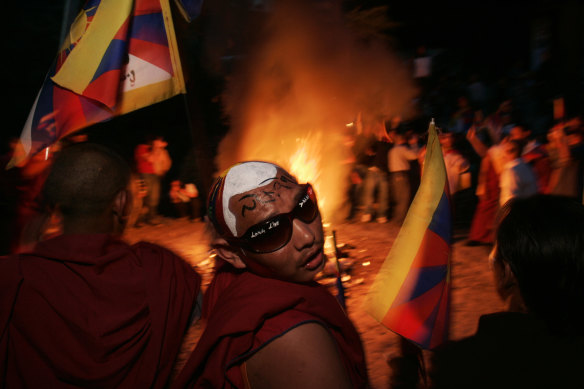
Tibetan exiles set fire to Chinese goods in Dharamshala in 2008 after a crackdown by Chinese troops against protests in Tibet.Credit: AP
I first encountered the Dalai Lama at a difficult moment for him and the Tibetan people. It was March 2008 and anti-China protests inside Tibet had turned violent, attracting global media attention. I was among a small group of journalists from around the world who assembled at the Dalai Lama’s residence to hear his take on the bloodshed. The press conference was sometimes tense as reporters questioned why he was not being more critical of the repressive tactics being used by Chinese authorities inside Tibet.
When my turn came, the Dalai Lama held my hand for some time and remarked on how far I had come to attend.
At one point, the Dalai Lama leant forward in his chair, fixed me with an intense gaze and described the predicament facing all Tibetans campaigning for greater autonomy for their homeland. “In the last few days, I have this sort of feeling of a young deer in the tiger’s grip,” he said, using his hands to mimic claws. “Can the deer really fight with the tiger? It can only express the truth. Our only weapon, our only strength, is justice and truth.”
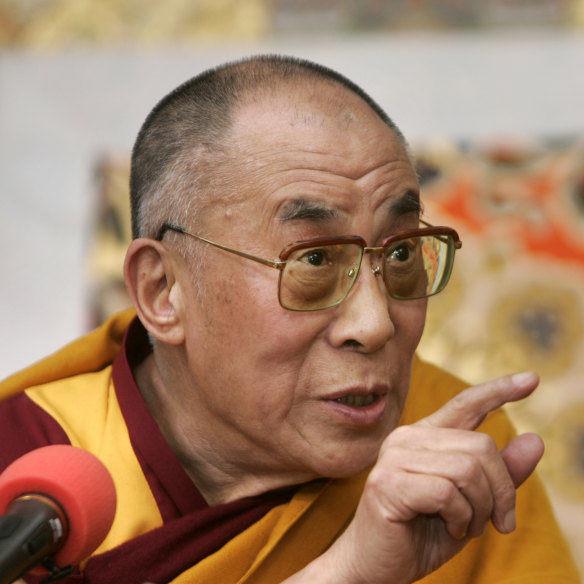
The Dalai Lama during a press conference in Dharamshala in March 2008. Credit: AP
The Dalai Lama also defended his middle way approach to China. “We must be practical,” he said.
The conclusion of that press conference was different to any I have experienced. The Dalai Lama stayed on to greet his inquisitors one at a time. With charm and grace, he shook hands, joked and chatted. Reporters now jostled to meet the famous monk they had been grilling minutes earlier.
When my turn came, the Dalai Lama held my hand for some time and remarked on how far I had come to attend. I left with a deeper appreciation of why this Dalai Lama is so widely admired.

An attendant carries the new Dalai Lama as he prepares to journey across the Himalayas to Lhasa, Tibet. Years later, he would flee to north India.Credit: Getty Images
How is a Dalai Lama selected?
When a Dalai Lama dies – or even before their death – a successor is found rather than chosen. Traditionally, senior Tibetan monks conduct an elaborate quest to find a child who is the Dalai Lama’s next incarnation. The search involves consulting oracles, interpreting visions and reading spiritual signs.
The senior monks may find clues from the deceased body of the Dalai Lama, such as the direction it faces or its posture. If the body is cremated, the direction of the smoke is monitored as a potential indicator for the direction of rebirth.
The boy was able to pinpoint artefacts that had belonged to the previous Dalai Lama. “It’s mine, it’s mine,” he is reported to have said.
Dreams are an important guide. Those involved in the search for the Dalai Lama’s reincarnation often meditate at Lhamo La-Tso, an oracle lake in central Tibet, and wait for a vision or insight into the whereabouts of the Dalai Lama’s rebirth.
Once these visions and signs have been followed up and a potential child has been found, there is a series of tests to verify the rebirth. The child is presented with artefacts, some of which belonged to the previous Dalai Lama. If the child identifies which objects belonged to the Dalai Lama, it is taken as a sign.
The current Dalai Lama was found at the age of two after a senior monk saw his village and house in a vision at the oracle lake. The boy – then named Lhamo Thondup – was able to pinpoint artefacts that had belonged to the previous Dalai Lama, including a drum used for rituals and a walking stick. “It’s mine, it’s mine,” he is reported to have said.
The boy was then educated by monks and prepared for his lifelong monastic role. In 1940, when he was five, he was officially installed as the spiritual leader of Tibet at the Potala Palace in the Tibetan capital, Lhasa, and was renamed Tenzin Gyatso.
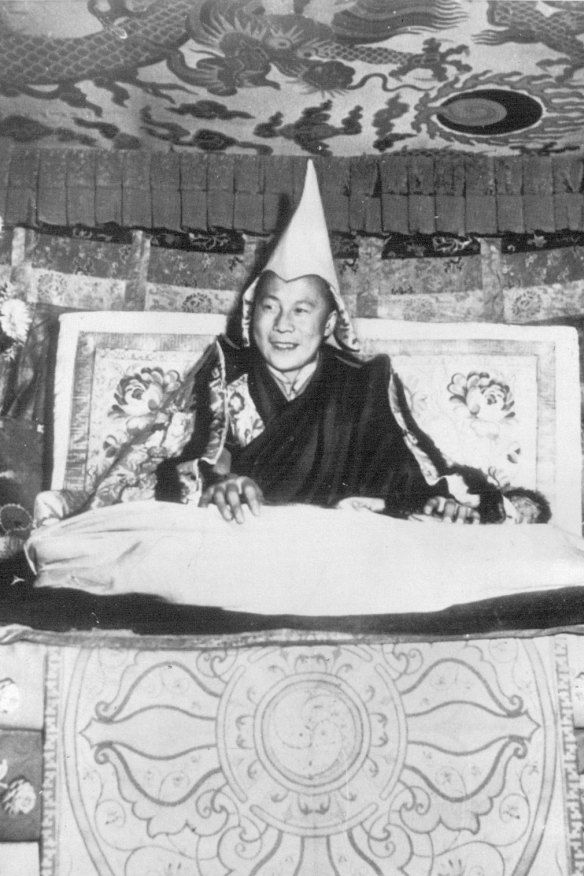
The Dalai Lama, aged 15, smiles from his throne in Lhasa in 1950. Credit: AP/Lowell Thomas jnr
Will finding the next Dalai Lama be different?
Identifying the next Dalai Lama will be especially tricky because politics is destined to complicate the search.
The Dalai Lama has hinted – often in a light-hearted way – that he could reappear anywhere, in any number of human incarnations, possibly as a woman. He’s even speculated that the Dalai Lama may no longer be needed (although he says that’s up to the Tibetan people).
In a 2011 speech about reincarnation, the Dalai Lama, said that at “about 90” years of age he will consult religious leaders, and the Tibetan public, to make a final decision about the selection of his successor. The primary responsibility for identifying his reincarnation will rest with officers of the Dalai Lama’s Gaden Phodrang Trust, which includes his most senior monastic disciples. He also vowed to leave “clear written instructions” on the process.
But the Chinese government already seems to have made its own plans. It claims the legal right to recognise Tibetan reincarnations. When the time comes to select a new Dalai Lama, China is expected to hand-pick its own candidate in a bid to ensure Tibet’s top Buddhist leader is friendly to Beijing. Chinese Foreign Ministry spokesman Geng Shuang said in 2019: “Reincarnation of living Buddhas including the Dalai Lama must comply with Chinese laws and regulations and follow religious rituals and historical conventions.”
A precedent was set during the last transition to a new Panchen Lama, the second most important figure in Tibetan religion, culture and politics.
In May 1995, the Dalai Lama himself recognised a six-year-old living in Tibet named Gedhun Choekyi Nyima as the new incarnation of the Panchen Lama. But the boy disappeared soon after and human rights groups say the Chinese government has kept him and his family in a secret location ever since.
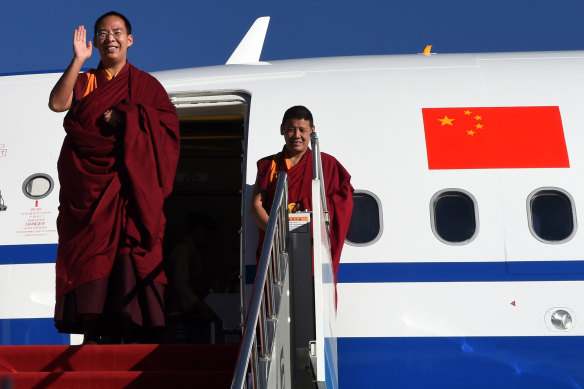
In 1995, the Chinese government announced that Gyaincain Norbu, shown here in 2015, would be the next incarnation of the Panchen Lama.Credit: Getty Images
The Chinese government announced the son of two Communist Party cadres, named Gyaincain Norbu, was the next reincarnation of the Panchen Lama.
Deakin University professor John Powers, who is a scholar of Tibetan Buddhism, says most Tibetans do not consider China’s choice to be legitimate.
“They think it’s ridiculous,” he says.
Even so, the scene is set for a complex struggle following the death of Tibet’s exiled spiritual leader.
The Dalai Lama himself has predicted his next incarnation will not be found in Chinese-controlled Tibet anyway. “My life is outside Tibet, therefore my reincarnation will logically be found outside,” he told Time magazine in 2004.
Chope Paljor Tsering, a former minister in Tibet’s government in exile who now lives in Canberra, says it makes spiritual sense for the Dalai Lama to be reincarnated beyond the control of Chinese authorities.
“You might even have an Australian Dalai Lama.”
“The very purpose of the next reincarnation is to continue the legacy of the previous person,” he says. “Therefore, if the next Dalai Lama is to be found while the current one is in exile still struggling for the freedom of the Tibetan people, and the preservation of Tibetan culture and religion, then obviously he will be reincarnated in a free country. That includes anywhere in the world where there is a sizeable Tibetan Buddhist community … you might even have an Australian Dalai Lama.”
However, the most likely non-Tibetan location for the Dalai Lama’s next incarnation is India, where more than 100,000 Tibetans live, most of them refugees.
What’s more, a Dalai Lama has previously been found within the borders of modern India. The sixth Dalai Lama was born in 1680 at Tawang in the eastern Himalayas, not far from India’s border with Tibet. The town’s imposing hilltop monastery is an important centre for Tibetan Buddhism. This makes Tawang a highly credible location for the next Dalai Lama to be found.
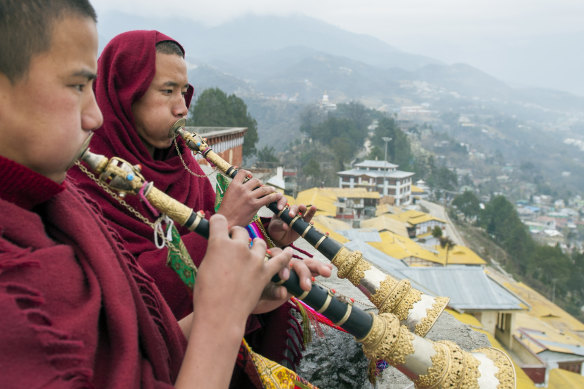
Monks at Tawang monastery, a credible location for finding the next Dalai Lama, in the Indian state of Arunachal Pradesh. China does not recognise Indian sovereignty over much of this region.Credit: Getty Images
Another alternative canvassed by the Dalai Lama’s supporters is that he identifies a reincarnation while he is still alive, possibly a well-credentialed teenage monk.
Chope Paljor Tsering says this option would be popular with Tibetans. “It will be very easy for Tibetans to accept such a concept,” he says. “There have been precedents for this – not with the Dalai Lama but with other very high-ranking religious leaders.”
“What you’ve basically got is two institutions claiming legitimacy to the process of the Dalai Lama’s reincarnation.”
But Powers says that recognising a reincarnation “while the incumbent is still alive” has been rare in the Tibetan Buddhist tradition.
While the method for identifying the Dalai Lama’s next incarnation remains uncertain, the transition promises to be contentious.
Dr Ruth Gamble, a La Trobe University academic who has studied the reincarnation traditions of Tibetan Buddhism, says the world is likely to end up with two new Dalai Lamas – one endorsed by the Chinese government, the other chosen by Tibetan monks in exile.
“What you’ve basically got is two institutions claiming legitimacy to the process of the Dalai Lama’s reincarnation,” she says.

Tourists at the Potala Palace in Lhasa: the winter palace of the Dalai Lama since the 7th century, it is a UNESCO World Heritage site. The Dalai Lama lives in exile in India. Credit: Getty Images
How will Tibetans respond?
It is difficult to know how the millions of Tibetans who live in China will react to the controversies that seem inevitable in the transition to the next Dalai Lama.
Critics of China’s policies in Tibet say censorship and propaganda mean a growing number of Tibetans are growing up with limited knowledge of their own culture and customs.
But Gamble is worried the Dalai Lama’s death could trigger unrest inside Tibet reminiscent of widespread protests in 2008, which Chinese security forces quelled.
“I’m really scared about what is going to happen on the ground in Tibet when the Dalai Lama dies,” Gamble says. “I don’t know what people will do.”
Powers believes any candidate for Dalai Lama endorsed by Beijing will not gain widespread acceptance. “The Chinese government is going to name a successor but no Tibetan Buddhist is going to accept this as valid,” he says.
The Dalai Lama himself told followers in 2011 not to recognise any candidate for his reincarnation “chosen for political ends by anyone, including those in the People’s Republic of China”.
He has also acknowledged the likelihood that two successors are named.
“In future, in case you see two Dalai Lamas come, one from [India], in a free country, and one chosen by the Chinese, then nobody will trust – nobody will respect [the one chosen by China],” he told Reuters in 2019. “So that’s an additional problem for the Chinese. It’s possible, it can happen.”
Chope Paljor Tsering says the Tibetan community is well prepared for the transition to a new Dalai Lama, whatever happens.
“I think people are very conscious of the fact that there is a strong, determined Chinese authority that will do whatever it takes for them to get control over the next Dalai Lama,” he says. “But the Tibetan Buddhist tradition is strong enough to withstand such action by an atheist authority so, in the long run, I think it is going to be OK.”

The Dalai Lama in March 2020. Credit: Getty Images
But could choosing a new Dalai Lama stoke tensions?
In December 2020, the US Congress passed landmark legislation reaffirming the rights of the Tibetan Buddhists to choose the Dalai Lama’s next incarnation without interference from China. The Tibet Policy and Support Act, signed into law by then-president Donald Trump, empowers the US government to impose sanctions on Chinese government officials who try to interfere in the process of selecting the next Dalai Lama.
In a speech supporting the law, US Speaker of the House of Representatives Nancy Pelosi said: “If we don’t speak out for human rights in China because of commercial interests, then we lose all moral authority to speak out for human rights in any other place in the world.”
The new law infuriated Beijing. The Chinese Foreign Ministry immediately accused the US of “meddling in China’s internal affairs” and said the move could further harm “co-operation and bilateral relations”.
The identification of a new Dalai Lama could also imperil relations between Asia’s giant, nuclear-armed neighbours, China and India. If Tibetan monks in exile find the Dalai Lama’s reincarnation within India, possibly in Tawang, it would provoke an angry reaction from the Chinese government and could feed into existing tensions between Beijing and Delhi.
“That would drive the Chinese absolutely berserk,” says Powers.
A popular reincarnation of the Dalai Lama living outside China could fuel another generation of agitation for Tibetan autonomy.
India’s willingness to host the Dalai Lama since he fled Tibet has vexed ties between the world’s two most populous countries for more than six decades. Says Powers: “The Chinese government has always protested to the Indian government for allowing a Tibetan government in exile to operate there.”
Relations between Beijing and Delhi deteriorated sharply in 2020 following deadly hand-to-hand clashes between Indian and Chinese troops at the disputed border between the two nations in the western Himalayas.
The transition to the next Dalai Lama looms as a flashpoint for India-China relations, says Ian Hall, professor of international relations at Griffith University. “This is something that causes acute anxiety in Delhi. His death is inevitable but when it happens it will cause problems.”
It’s difficult to know exactly how the transition to the next Dalai Lama will play out. But when the time comes, the world will be watching.
Let us explain
If you'd like some expert background on an issue or a news event, drop us a line at explainers@smh.com.au or explainers@theage.com.au. Read more explainers here.